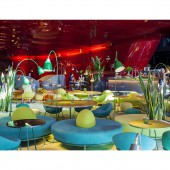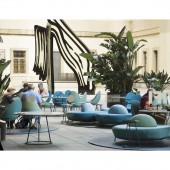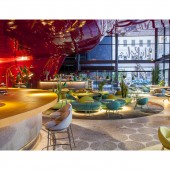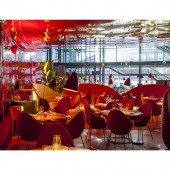
| THE AWARD |
| CATEGORIES |
| REGISTRATION |
| SUBMIT YOUR WORK |
| ENTRY INSTRUCTIONS |
| TERMS & CONDITIONS |
| PUBLICATIONS |
| DATES & FEES |
| METHODOLOGY |
| CONTACT |
| WINNERS |
| PRESS ROOM |
| GET INVOLVED |
| DESIGN PRIZE |
| DESIGN STORE |
| THE AWARD | JURY | CATEGORIES | REGISTRATION | PRESS | WINNERS | PUBLICATIONS | ENTRY INSTRUCTIONS |
Nubel Restaurant by Paula Rosales |
Home > Winners > Design #57264 >Interview |
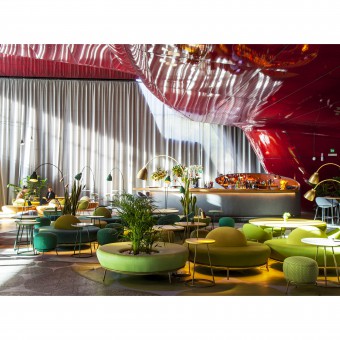 |
|
FS: What is the main principle, idea and inspiration behind your design?
PR: More than a "decoration", I designed a very flexible "fractal system" to organize the space. The iterative structure is the circle, as a unifying geometrical form, present in gastronomy, nature and architecture.
FS: What has been your main focus in designing this work? Especially what did you want to achieve?
PR: My main focus was to create a memorable experience for all the user of NuBel.
FS: What are your future plans for this award winning design?
PR: I am trying to launch and sell the furniture and lighting collection designed for NuBel. It is a new business and challenge.
FS: How long did it take you to design this particular concept?
PR: It took me 5 months: The project started in April 2016, as the winner entry at a competition organized by the National Museum of Modern Art Reina Sofia. Located in Madrid, at the museum extension building, below the Jean Nouvel designed auditorium. It was finished and opened to the public on October 2016.
FS: Why did you design this particular concept? Was this design commissioned or did you decide to pursuit an inspiration?
PR: This design was commissioned by the restaurant owner after we won a design competition organized by the national museum of modern art Reina Sofía. The requirements of the project located in the existing building by Jean Nouvel, led me to design all the furniture, lighting, rugs and elements of the restaurant, to produce a unique experience, based on the circle as a focus geometry, a meeting point where a world of flavors and colors blend as in a watercolor.
FS: Is your design being produced or used by another company, or do you plan to sell or lease the production rights or do you intent to produce your work yourself?
PR: I intent to produce my work myself, although I don´t discard selling the production rights if I find the right company.
FS: What made you design this particular type of work?
PR: In the existing cafeteria, we observed problems of use/comfort: noise, bad lighting, lack of spatial structure. We collected info on user’s typologies and spontaneous activities taking place: work meetings, resting tourists, coffee breaks, museum lunches. We had to respond to this variety of situations while making it a comfortable place.
FS: Who is the target customer for his design?
PR: Restaurants, hotels, offices and any owner that wants to create an island of rest and comfort in an open space of a building.
FS: What sets this design apart from other similar or resembling concepts?
PR: The way the different pieces work together, and help people to relate to each other in a very easy and natural way.
FS: How did you come up with the name for this design? What does it mean?
PR: When I considered what to do under Jean Nouvel's bold “red sky”, I felt that my intervention would be sensual and feminine. A design that would blend emotion and function and float over the floor: a garden of clouds (“nubes” in Spanish). From the word “nube” and the sound of Nouvel´s name, we came up with NuBel.
FS: Which design tools did you use when you were working on this project?
PR: We used 3d programs, Autocad, and Photoshop, in order to draw and visualize the shapes and colors we were designing.
FS: What is the most unique aspect of your design?
PR: The round shape of furniture, lights and objects, made them work as a system of fractals or cells that can be grouped or isolated, depending on the organ they are forming. In this way, this cells allow different configurations, and diverse uses of the space. The wide range of sizes, colors, and shapes of these objects allows the users to choose what configuration matches better their mood, age or circumstances, and allows the restaurant to simultaneously attend the heterogeneous public of the museum and the city.
FS: Who did you collaborate with for this design? Did you work with people with technical / specialized skills?
PR: My office team worked hard with me in the whole process, especially architects Artemisa Espinosa , Cristina Felipe. Other team architects were Natalia Escudero, Kenneth Kim, Alfredo Domenech, Nain Homes and Lilian Flores. My dear friend and designer Alicia Velazquez was key to the initial inspiration and gave us good feedback during the whole process, with her special attention to emotion and body centered design. Toni Rueda, who collaborates regularly with the museum Reina Sofía in their art installations, gave us his feedback as a lighting consultant. And Alejandro Sansegundo studied and measured the acoustics to make sure the space was comfortable.
FS: What is the role of technology in this particular design?
PR: Technology was used to produce the organic shaped furniture and to custom print the rug with our watercolor like designs.
FS: Is your design influenced by data or analytical research in any way? What kind of research did you conduct for making this design?
PR: Besides research on the existing problems of the space before renovation: noise, bad lighting, lack of spatial structure, we collected information on the type of users and spontaneous activities taking place. We came up with a set of situations that our design had to respond to. Being at a museum, we also researched in ART, choosing abstract paintings to reflect our atmosphere and colors, and to connect to the world of gastronomy.
FS: What are some of the challenges you faced during the design/realization of your concept?
PR: Location was a big challenge: an important museum, on a building designed by a famous architect: Jean Nouvel. A difficult space under the red shining ceiling of an auditorium. Timing was another concern: 5 months to design and produce it all, with summer vacations included. And of course, the wide range of situations that our design had to respond to: very heterogeneous public, wide schedule from 10am to 2am, and events of all sorts.
FS: How did you decide to submit your design to an international design competition?
PR: I realized the design was very successful since the restaurant opened. I wanted it to get more international visibility in order to get more projects for my office, and to sell the furniture and light collection.
FS: What did you learn or how did you improve yourself during the designing of this work?
PR: I learned about product design at a wider scale than I was used to as an architect.
FS: Thank you for providing us with this opportunity to interview you.
A' Design Award and Competitions grants rights to press members and bloggers to use parts of this interview. This interview is provided as it is; DesignPRWire and A' Design Award and Competitions cannot be held responsible for the answers given by participating designers.
| SOCIAL |
| + Add to Likes / Favorites | Send to My Email | Comment | View Press-Release |
